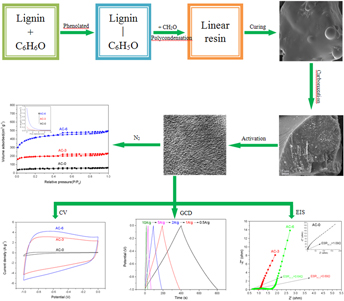Article contents
Preparation and electrochemical capacitive performance of phenolated calcium lignosulfonate-based phenol formaldehyde resin porous carbon
Published online by Cambridge University Press: 06 March 2018
Abstract

Lignin-based phenol formaldehyde resin was synthesized using phenolated calcium lignosulfonate, and porous carbon with good wettability was prepared after carbonization and potassium hydroxide (KOH) activation. The results indicated that when the KOH to the carbonized sample mass ratio was 6:1, the prepared carbon had a rich porous structure and higher surface area, with a specific surface area of 1320.13 m2/g. Furthermore, the porous carbon exhibited a maximum specific capacitance of 204.88 F/g at a current density of 0.5 A/g in the potential range −1.0 to 0 V in a 6 M KOH solution and a low equivalent series resistance of 0.64 Ω. The phenolated calcium lignosulfonate-based phenol formaldehyde resin porous carbon demonstrated a favorable electric double-layer performance.
Keywords
Information
- Type
- Article
- Information
- Journal of Materials Research , Volume 33 , Issue 9: Focus Issue: Porous Carbon and Carbonaceous Materials for Energy Conversion and Storage , 14 May 2018 , pp. 1211 - 1218
- Copyright
- Copyright © Materials Research Society 2018
Footnotes
Contributing Editor: Tianyu Liu
References
REFERENCES
- 3
- Cited by


